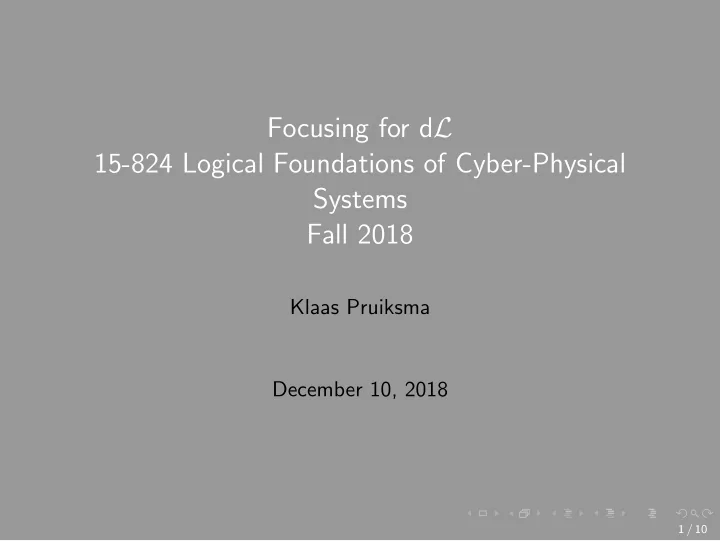

Focusing for d L 15-824 Logical Foundations of Cyber-Physical Systems Fall 2018 Klaas Pruiksma December 10, 2018 1 / 10
Goal Develop a focused version of Differential Dynamic Logic(d L ) [3], with the intent that it serve as a basis for future work on the proof theory of d L . 2 / 10
What is focusing? Focused systems of proof, first described by Andreoli [1], restrict what proofs can be constructed. Each focused proof corresponds to a set of unfocused proofs. Two major restrictions: • Apply “invertible” proof rules when possible. • When no invertible rules can be applied, “focus” on a formula and apply non-invertible rules to it until no longer possible. 3 / 10
d L ? d L , or Differential Dynamic Logic, is the system of logic we use to model the behaviour of hybrid systems and to prove properties of those models. 4 / 10
Approach Followed (at a high level) the approach of Simmons [4]: • Split the connectives of the logic into synchronous and asynchronous based on their behaviour when broken down by proof rules. • Modify the sequent calculus to distinguish the two phases of proof construction. • Prove logical properties of the resulting system (cut elimination, identity expansion) • Derive soundness and completeness results from those properties 5 / 10
Results • A sound (but not complete) focused system for d L . • Completeness fails (for this particular system) due to iteration [ α ∗ ]. • Iteration breaks both cut elimination and identity expansion in this focused setting for separate reasons. 6 / 10
What goes wrong with iteration? Two separate issues: • Cut elimination fails (or at least is difficult to prove) because of the global rules that break down iteration — the rules for loop invariants and variants. • (The proof of) identity expansion fails because the rules for breaking down iterations do not reduce the formula to one that is structurally simpler. 7 / 10
Future Work • Fix the issues with iteration to arrive at a sound and complete focused system. • Investigate how such a system may be of use for normalizing proofs in a more general sense. 8 / 10
References I [1] Jean-Marc Andreoli. Logic programming with focusing proofs in linear logic. Journal of Logic and Computation , 2(3): 297–347, 1992. [2] Chuck Liang and Dale Miller. Focusing and polarization in linear, intuitionistic, and classical logics. Theoretical Computer Science , 410(46):4747–4768, 2009. [3] Andr´ e Platzer. Differential dynamic logic for hybrid systems. J. Autom. Reas. , 41(2):143–189, 2008. ISSN 0168-7433. doi: 10.1007/s10817-008-9103-8 . [4] Robert J Simmons. Structural focalization. ACM Transactions on Computational Logic (TOCL) , 15(3):21, 2014. 9 / 10
Questions? 10 / 10
Recommend
More recommend